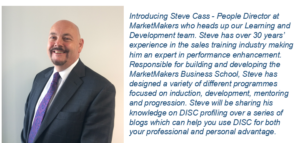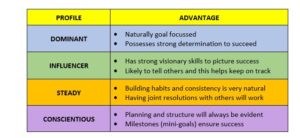Linking DISC to our New Year’s Resolutions

Let me start by wishing you a very Happy New Year! Today we are going to take a look at something that so many people do on that first day of the New Year .… the New Year’s Resolutions.
The idea of making a New Year’s Resolution has been around for thousands of years and originally the resolution would have been in the shape of a promise to the Gods. Today, most resolutions are a self-promise. In this blog we are going to explore how we can ensure that our ‘self-promise’ is going to last the whole year, and beyond, by linking this to our DISC profile.
First a few scary facts; people that make a New Year’s Resolution in January, by the first week 22% of them will have already broken that resolution! By the beginning of February that figure has moved up to 40%. After 6 months around 60% will have forgotten all about the resolution, and sadly only 19% of people will have made their New Year’s Resolution a reality by the end of the year.
So why do so many people fail in making it through the year? The good thing is that the answers to this are very simple. Essentially, there are three major reasons why people fall down:
- No plan
- An unclear or vague goal
- Unrealistic outcome
Let’s start with the first point. The quotation of “If you fail to plan, then you can only plan to fail” is very appropriate here. It has been said that development is a journey, therefore if we are going to go on our journey of resolutions we need a sat-nav to show us the way – that’s where our plan comes in.
The second point may come about because the resolution was probably made at about 00.02 on the 1st of January! Do the phrases “I’m really going to get fitter this year” sound familiar? Or perhaps “I’m definitely going to lose weight”, other ‘classics’ include “This year I’m so going to see more of the world”, “2018 is the year I become rich”, and many others. All of these aspirations are very non-specific and really hard to measure. Technically, you can lose a single gram in weight and you have “lost weight” but is that actually what you meant – also there’s nothing in there about maintaining the weight loss. The same goes for being ‘fitter’ and as for being ‘richer’ I could give that person £5 and they would be ‘richer’, is that what they meant? – I don’t think so!
Our final faux-par is the unrealistic goal. Typically this is where our intentions are good although the reality is quite different. For example a desire to stop smoking is a great New Year’s Resolution, but to say “that’s it, I’m not going to have another cigarette for the rest of the year!” is very idealistic, but incredibly hard to achieve. Of course some people will do this and it’ll work – they are the ones that fall into our 19% that keep their resolutions, not so good for the other 81%. There are so many examples of this, including “I’m going to go to the gym 5 times a week starting tomorrow” – this is fine, if you already go to the gym Monday to Thursday! How about “Not a single chocolate is going to pass my lips in January” is all well and good, until February and then it becomes a total chocolate binge when the shops open on the 1st February!
So, let’s get down to business and understand how to ensure your New Year’s Resolution becomes a reality and not just an aspiration or dream.
Each of the four DISC profiles have their own advantages when it comes to making sure the resolution sticks throughout the year.
To make it easy here is a quick overview of each profile:

Next step is to consider, in detail, what the resolution actually is. Recent research has determined that 95% of New Year’s Resolutions fall into one of 6 categories, in this order:

Rather than saying “I want to be fitter” consider what that actually means, for example;
- Being able to run a specific distance in a set time
- By July I will have lost 20 kg
- I will be able to wear this dress/these trousers by March 22nd and I’ll look great in them!
- As a group, by the end of the year, we will have lost the equivalent of an adult (155 llbs)
- By May 31st my biceps will measure 16 inches
All these possibilities above can also be linked to DISC. The Dominant and Conscientious will both respond well to the numbers element. Specifically, the challenge aspect (perhaps a half marathon, for example) will ensure the Dominant profile is engaged, whilst looking good, and the visual aspects, will work for the Influencer. The group challenge is going to work for our Steady profile.
Once we have our clear and measurable target, which ideally will be linked to our profile, it’s all about the planning.
The Conscientious profile will naturally do this, as for the rest of us it is crucial to have mini-goals or review periods along the way. This ensures that the resolution is far more achievable and realistic.
For example, if we wanted to save £3,000 this year then by breaking it down it suddenly becomes far more achievable. Each quarter I need to bank £750. Which means if I save £250 each month I will be on target, and actually, that’s about £58 a week or better still £8.50 a day. When we look at like this it feels far more realistic. The other element to it is that we will get into the habit of saving and then it doesn’t seem so much of a chore.
To take it even further – what am I going to do with that £3,000? Once you know this then you can start to use more visualisation. Here’s one for the Influencers….I once met a chap who wanted to buy a car and then he calculated the cost of all the vital components; engine, tyres, seats, brakes, etc and then each time he saved money he built his car, conceptually, until he finally had enough money to buy the real thing.
OK, that’s all for now. Following this blog, if you really want to make your New Year’s Resolution happen, do these three things:
Write it down and look at the resolution regularly
- Have a clear, measurable and achievable goal
- Plan how you are going to ensure success with mini-goals/reviews
Oh, and actually there’s a fourth thing – link it to your DISC profile!!
See you next time.
Tags: DISC, goal, goal setting, goals, new year, new you, resolutions
